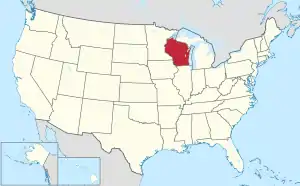Jackson County, Wisconsin
Jackson County is a county located in the U.S. state of Wisconsin. As of the 2010 census, the population was 20,449.[1] Its county seat is Black River Falls.[2] Jackson County was formed from Crawford County in 1853. It was named for President Andrew Jackson.[3]
Jackson County | |
|---|---|
 Jackson County courthouse | |
 Location within the U.S. state of Wisconsin | |
 Wisconsin's location within the U.S. | |
| Coordinates: 44°19′N 90°49′W | |
| Country | |
| State | |
| Founded | 1853 |
| Named for | Andrew Jackson |
| Seat | Black River Falls |
| Largest city | Black River Falls |
| Area | |
| • Total | 1,000 sq mi (3,000 km2) |
| • Land | 988 sq mi (2,560 km2) |
| • Water | 13 sq mi (30 km2) 1.3%% |
| Population (2010) | |
| • Total | 20,449 |
| • Estimate (2019) | 20,643 |
| • Density | 20/sq mi (7.9/km2) |
| Time zone | UTC−6 (Central) |
| • Summer (DST) | UTC−5 (CDT) |
| Congressional districts | 3rd, 7th |
| Website | www |
Geography
According to the U.S. Census Bureau, the county has a total area of 1,000 square miles (2,600 km2), of which 988 square miles (2,560 km2) is land and 13 square miles (34 km2) (1.3%) is water.[4]
Adjacent counties
- Clark County - north
- Wood County - east
- Juneau County - southeast
- Monroe County - south
- La Crosse County - southwest
- Trempealeau County - west
- Eau Claire County - northwest
Major highways
|
|
Demographics
| Historical population | |||
|---|---|---|---|
| Census | Pop. | %± | |
| 1860 | 4,170 | — | |
| 1870 | 7,687 | 84.3% | |
| 1880 | 13,285 | 72.8% | |
| 1890 | 15,797 | 18.9% | |
| 1900 | 17,466 | 10.6% | |
| 1910 | 17,075 | −2.2% | |
| 1920 | 17,746 | 3.9% | |
| 1930 | 16,468 | −7.2% | |
| 1940 | 16,599 | 0.8% | |
| 1950 | 16,073 | −3.2% | |
| 1960 | 15,151 | −5.7% | |
| 1970 | 15,325 | 1.1% | |
| 1980 | 16,831 | 9.8% | |
| 1990 | 16,588 | −1.4% | |
| 2000 | 19,100 | 15.1% | |
| 2010 | 20,449 | 7.1% | |
| 2019 (est.) | 20,643 | [5] | 0.9% |
| U.S. Decennial Census[6] 1790–1960[7] 1900–1990[8] 1990–2000[9] 2010–2019[1] | |||

As of the census[10] of 2000, there were 19,100 people, 7,070 households, and 4,835 families residing in the county. The population density was 19 people per square mile (7/km2). There were 8,029 housing units at an average density of 8 per square mile (3/km2). The racial makeup of the county was 89.58% White, 2.27% Black or African American, 6.16% Native American, 0.16% Asian, 0.04% Pacific Islander, 1.01% from other races, and 0.79% from two or more races. 1.87% of the population were Hispanic or Latino of any race. 31.4% were of German, 30.2% Norwegian and 5.2% Irish ancestry. 94.7% spoke English, 2.2% Spanish and 1.5% Winnebago as their first language.
There were 7,070 households, out of which 31.00% had children under the age of 18 living with them, 55.40% were married couples living together, 8.60% had a female householder with no husband present, and 31.60% were non-families. 26.20% of all households were made up of individuals, and 11.80% had someone living alone who was 65 years of age or older. The average household size was 2.49 and the average family size was 3.00.
In the county, the population was spread out, with 24.10% under the age of 18, 8.80% from 18 to 24, 29.40% from 25 to 44, 22.80% from 45 to 64, and 14.90% who were 65 years of age or older. The median age was 38 years. For every 100 females there were 114.60 males. For every 100 females age 18 and over, there were 116.30 males.
In 2017, there were 227 births, giving a general fertility rate of 74.0 births per 1000 women aged 15–44, the 10th highest rate out of all 72 Wisconsin counties. Of these, 14 of the births occurred at home.[11] Additionally, there were 7 reported induced abortions performed on women of Jackson County residence in 2017.[12]
Communities



City
- Black River Falls (county seat)
Villages
Towns
Unincorporated communities
Ghost towns/neighborhoods
Politics
| Year | Republican | Democratic | Third parties |
|---|---|---|---|
| 2020 | 56.9% 5,789 | 41.8% 4,255 | 1.3% 136 |
| 2016 | 52.9% 4,906 | 41.2% 3,818 | 5.9% 543 |
| 2012 | 41.9% 3,900 | 56.9% 5,298 | 1.2% 115 |
| 2008 | 38.4% 3,552 | 60.2% 5,572 | 1.4% 127 |
| 2004 | 45.1% 4,387 | 54.0% 5,249 | 0.9% 90 |
| 2000 | 43.6% 3,670 | 52.0% 4,380 | 4.4% 367 |
| 1996 | 31.1% 2,262 | 50.9% 3,705 | 18.0% 1,312 |
| 1992 | 31.4% 2,644 | 43.7% 3,681 | 24.9% 2,093 |
| 1988 | 47.3% 3,555 | 52.2% 3,924 | 0.5% 38 |
| 1984 | 55.8% 4,386 | 43.6% 3,427 | 0.6% 46 |
| 1980 | 50.8% 4,327 | 42.6% 3,629 | 6.6% 561 |
| 1976 | 46.9% 3,406 | 51.4% 3,735 | 1.7% 123 |
| 1972 | 60.8% 3,937 | 37.8% 2,445 | 1.5% 94 |
| 1968 | 52.9% 3,172 | 38.2% 2,293 | 8.9% 534 |
| 1964 | 39.8% 2,532 | 60.1% 3,818 | 0.1% 7 |
| 1960 | 58.0% 3,950 | 41.8% 2,849 | 0.2% 14 |
| 1956 | 56.7% 3,614 | 43.2% 2,755 | 0.1% 9 |
| 1952 | 59.9% 4,235 | 39.9% 2,819 | 0.2% 17 |
| 1948 | 45.9% 2,553 | 52.5% 2,921 | 1.6% 89 |
| 1944 | 50.9% 3,182 | 48.6% 3,040 | 0.5% 34 |
| 1940 | 48.1% 3,741 | 51.1% 3,975 | 0.8% 64 |
| 1936 | 32.0% 2,235 | 65.0% 4,537 | 3.0% 207 |
| 1932 | 33.5% 1,983 | 64.4% 3,813 | 2.1% 123 |
| 1928 | 75.2% 4,353 | 23.6% 1,364 | 1.3% 74 |
| 1924 | 32.2% 1,662 | 5.0% 255 | 62.8% 3,238 |
| 1920 | 85.9% 3,652 | 9.7% 410 | 4.4% 188 |
| 1916 | 64.2% 1,866 | 33.1% 963 | 2.7% 79 |
| 1912 | 52.8% 1,398 | 22.9% 606 | 24.4% 645 |
| 1908 | 77.9% 2,603 | 18.9% 631 | 3.2% 107 |
| 1904 | 82.8% 2,746 | 14.4% 479 | 2.8% 93 |
| 1900 | 77.7% 2,639 | 19.2% 651 | 3.1% 105 |
| 1896 | 74.6% 2,710 | 21.4% 778 | 4.0% 146 |
| 1892 | 59.8% 2,078 | 33.4% 1,160 | 6.9% 239 |
Economy
The county's largest employer is the Ho-Chunk Nation, which employs roughly 3100 people combined in Jackson and Sauk counties.[14]
References
- "State & County QuickFacts". United States Census Bureau. Archived from the original on June 6, 2011. Retrieved January 21, 2014.
- "Find a County". National Association of Counties. Archived from the original on May 31, 2011. Retrieved June 7, 2011.
- Gannett, Henry (1905). The Origin of Certain Place Names in the United States. Govt. Print. Off. pp. 167.
- "2010 Census Gazetteer Files". United States Census Bureau. August 22, 2012. Retrieved August 5, 2015.
- "Population and Housing Unit Estimates". Retrieved March 26, 2020.
- "U.S. Decennial Census". United States Census Bureau. Retrieved August 5, 2015.
- "Historical Census Browser". University of Virginia Library. Retrieved August 5, 2015.
- Forstall, Richard L., ed. (March 27, 1995). "Population of Counties by Decennial Census: 1900 to 1990". United States Census Bureau. Retrieved August 5, 2015.
- "Census 2000 PHC-T-4. Ranking Tables for Counties: 1990 and 2000" (PDF). United States Census Bureau. April 2, 2001. Retrieved August 5, 2015.
- "U.S. Census website". United States Census Bureau. Retrieved May 14, 2011.
- Annual Wisconsin Birth and Infant Mortality Report, 2017 P-01161-19 (June 2019): Detailed Tables
- Reported Induced Abortions in Wisconsin, Office of Health Informatics, Division of Public Health, Wisconsin Department of Health Services. Section: Trend Information, 2013-2017, Table 18, pages 17-18
- Leip, David. "Dave Leip's Atlas of U.S. Presidential Elections". uselectionatlas.org. Retrieved November 9, 2020.
- http://witribes.wi.gov/docview.asp?docid=5638&locid=57
Further reading
- Biographical History of Clark and Jackson Counties, Wisconsin. Chicago: Lewis Publishing Co., 1891.
External links
- Jackson County
- Jackson County map from the Wisconsin Department of Transportation
- Jackson County Health and Demographic Data
